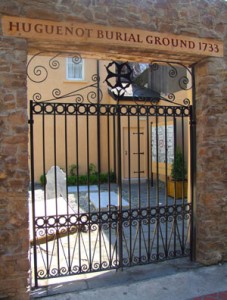Where did the Huguenot refugees in Ireland bury their dead?
Huguenots spread throughout Ireland and consequently they were buried in graveyards in the communities in which they lived. Some graveyards were used exclusively for Huguenots, others were buried with their Irish neighbours. In Portarlington, the French Church records continued to be recorded in French for more than 150 years following the arrival of the first Huguenot French refugees to that area.
Some examples of places where Huguenots were buried include ‘The Cabbage Patch’ near St. Patrick’s Cathedral; New Market in the Liberties; and Merrion Row near Stephen’s Green – all in Dublin City; Carey’s Lane in Cork City; and the above-mentioned French Church in Portarlington. Some Huguenot remains, originally buried in ‘Peter Street’ near Aungier Street in Dublin City centre, were later moved to ‘Mount Jerome’ cemetery in South Dublin.
Huguenot Cemetery, Near French Church Street, Cork
Of the approximately 5000 French Huguenots who came to Ireland, about 300 settled in Cork. They quickly became involved in the commercial and civic life of the City and no less than eleven Huguenots served as Mayors of Cork City between 1694 and 1840. In 2006, Cork City Council acquired a property off Carey’s Lane near French Church Street in Cork, which had formerly been a Huguenot burial ground.
The burial ground was restored by the Council and visitors can now view it and learn more about the history of the Huguenot presence in Cork. To view a list of Huguenot Names associated with Cork, please click here.
Huguenot Cemetery, Merrion Row, Dublin
Huguenot Cemetery Dublin who were buried in the small Huguenot Cemetery at Merrion Row in the heart of Dublin City. This cemetery, dating from 1693, is just one of several French Huguenot burial grounds in Ireland.
Although the Cemetery can be viewed through the gates by passer-by, the gates are usually kept locked and the Cemetery is maintained by Dublin City Council.


